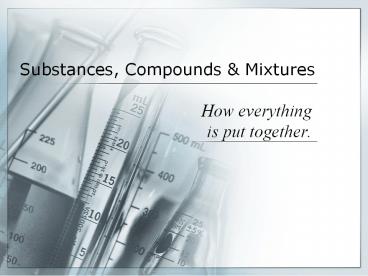Substances, Compounds - PowerPoint PPT Presentation
1 / 23
Title:
Substances, Compounds
Description:
Substances, Compounds & Mixtures How everything is put together. Substances Matter that has the same composition and properties throughout is called a substance. – PowerPoint PPT presentation
Number of Views:130
Avg rating:3.0/5.0
Title: Substances, Compounds
1
Substances, Compounds Mixtures
- How everything is put together.
2
Substances
- Matter that has the same composition and
properties throughout is called a substance. - When different elements combine, other substances
are formed.
3
Substances
- Contains only one particle
- Can exist in 3 states of matter
- Can be elements or compounds
Picture from http//www.ilpi.com/msds/ref/gifs/sta
tesofmatter.gif
4
Compounds
- A compound is a substance whose smallest unit is
made up of atoms of more than one element bonded
together. - Compounds often have properties that are
different from the elements that make them up. - Examples Water, salt, sugar
5
Compounds Have Formulas
- H20 is the chemical formula for water, and H2O2
is the formula for hydrogen peroxide. - The formula tells you which elements make up a
compound as well as how many atoms of each
element are present.
6
How to read a formula
H20
This is a subscript. It tells us how many atoms
of that element exist in one unit of that
compound. Hydrogen is made of 2 H atoms and 1 O
atom. No subscript is used when only one atom of
an element is present.
7
Lets try it
- Using your white board tell how many atoms there
are in each element. - Sulfuric Acid H2SO4
- 2 Hydrogen
- 4 Oxygen
- Hydrogen Peroxide H2O2
- 2 Hydrogen
- 2 Oxygen
8
And some more formulas
- Carbon Dioxide CO2
- 1 Carbon
- 2 Oxygen
- Carbon Monoxide CO
- 1 Carbon
- 1 Oxygen
- Calcium Carbonate (Found in shells, eggshells,
antacid) CaCO3 - 1 Calcium
- 1 Carbon
- 3 Oxygen
9
Compound Review
- A pure compound has the same elements and the
same amount of elements all of the time - Elements are chemically combined
- Compound properties are different from the
properties of the elements - They cannot be separated physically
- Physical properties such as boiling point or
melting point of pure substances are do not
change
10
Mixtures
- A mixture is a combination of two or more
substances where there is no chemical combination
or reaction.
11
A mixture is a combination of two or more
substances where there is no chemical combination
or reaction.
12
Mixtures combine physically in no specific
proportions. They just mix.
13
Solids, liquids and gases can be combined to
create a mixture.
14
Mixture Types
- MIXTURES MAY BE HOMOGENEOUS OR HETEROGENEOUS
15
Homogeneous Mixtures
- Homogeneous Mixtures
- The prefix "homo"- indicates the same
- Have the same uniform appearance and composition
throughout
16
Solutions
- SOLUTIONS
- are homogeneous mixtures
17
What is a solution?
- A solution is a mixture of two or more
substances. - At least two substances must be mixed in order to
have a solution
18
A solution has two parts
- The substance in the smallest amount and the one
that DISSOLVES is called the SOLUTE
- The substance in the larger amount is called the
SOLVENT - it does the dissolving - IN most common instances water is the solvent
19
Examples of solutions
- Salt water
- Clean Air
- Vinegar
20
Heterogeneous Mixtures
- The prefix "hetero"- indicates difference
- A heterogeneous mixture consists of visibly
different substances or phases - Two or more parts can be seen
21
Examples
- Pizza
- Sandwich
- Chex Mix
22
Suspensions
- A SUSPENSION is a heterogeneous mixture of large
particles - These particles are visible and will settle out
on standing - Examples of suspensions are fine sand or silt in
water or Italian salad dressing
23
Compounds vs Mixtures
Mixtures
Compounds
Not chemically combined
Combine chemically forming molecules
Can combine in any proportion
Combine in set proportions
Separated chemically
Separated physically

